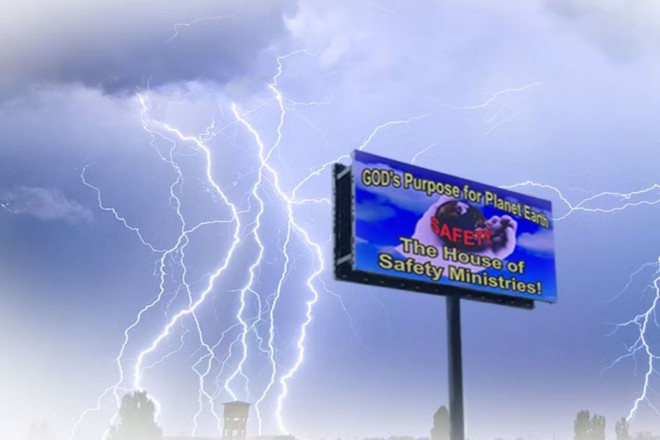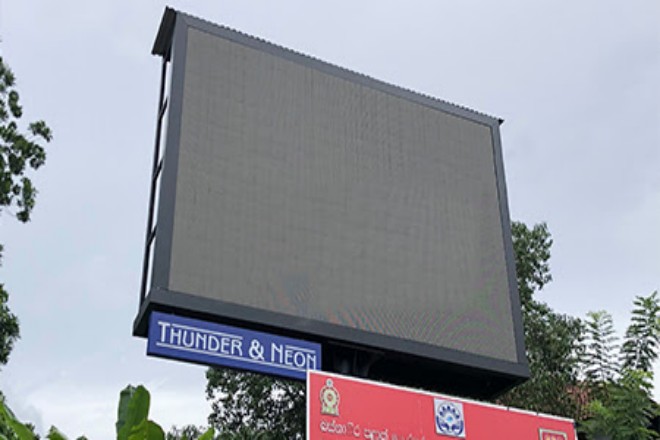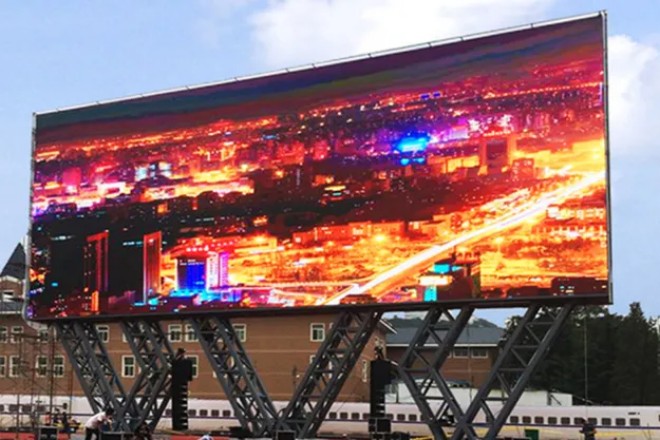Introducción

Como herramienta importante para la difusión de información moderna, pantallas de visualización LED are widely used in various fields with their unique advantages. However, thunderstorms pose a severe challenge to the safety of electronic equipment.
The powerful force of lightning may cause irreversible damage to LED display screens and even threaten public safety. Therefore, how to protect LED display screens in thunderstorms and ensure their stable operation has become an important issue we must face.
1. The impact mechanism of thunderstorms on LED display screens
Thunderstorms, as a common phenomenon in nature, always carry its unique uncertainty and power. For LED display screens, such weather conditions may bring a series of potential impacts.
Although these impacts are not always catastrophic, it is still crucial to understand them and take appropriate precautions.
1). Direct lightning strikes:
Although it is rare for lightning to strike LED display screens, once it occurs, the consequences are often very serious. The high voltage and high current carried by lightning can instantly destroy the electronic components of the display screen, causing irreversible damage.
This direct strike will not only cause the display screen to fail to work properly but may also cause more serious safety problems such as fire.
Therefore, when installing an LED display, it is necessary to ensure that it has effective lightning protection measures, such as installing lightning rods and lightning strips, to reduce the risk of direct lightning strikes.
2). Inductive lightning:
Compared with direct lightning strikes, inductive lightning is a more common threat to LED displays. The electromagnetic pulses generated by lightning discharge will propagate in the surrounding space.
These pulses may enter the interior of the display through power lines, signal lines, etc., causing interference or damage to its electronic components. This interference may cause problems such as image flickering, distortion, or failure to display normally on the display.
In order to deal with the threat of inductive lightning, a variety of measures can be taken, such as installing lightning arresters and using shielded cables to reduce the impact of electromagnetic pulses on the display.
3). Power supply fluctuations and power outages:
During thunderstorms, the power grid may encounter unstable factors such as unstable voltage, short circuits, and even power outages.
These unstable factors will have a direct impact on the normal operation of LED displays. Unstable voltage may damage the electronic components of the display, while power outages will cause the display to fail to work properly.
2. What are the lightning protection measures and designs for LED displays?

1). Built-in lightning protection device of LED display
The first thing we touch upon is its built-in lightning protection device. This constitutes the first solid barrier against lightning attacks. Especially for those outdoor LED display screens standing on the top of high-rise buildings or in the open field, the role of lightning rods is particularly important.
With their cutting-edge discharge wisdom, they cleverly guide the violent power of lightning to the depths of the earth, effectively avoiding the catastrophic damage to the display screen caused by direct lightning strikes. It is worth noting that the installation position and height of the lightning rod are based on precise professional calculations to maximize its protection effectiveness.
2). Lightning arrester on the power supply and signal transmission lines
Next, the lightning arrester, as another key line of defense, is carefully arranged on the power supply and signal transmission lines of the display screen.
Once lightning causes overvoltage or overcurrent to attack the display screen, the lightning arrester will immediately start, like a loyal guard, limiting these potentially destructive forces within the safety threshold and providing a protective umbrella for the electronic components of the display screen.
In the lightning arrester family, the power lightning arrester and the signal lightning arrester each perform their duties and jointly protect the safety of the power line and signal line.
3). Grounding system of wires
The stable operation of all this is inseparable from a solid backing – the grounding system. This system is composed of key elements such as grounding bodies, grounding grids, and grounding wires.
They work together to build a low-impedance current discharge channel to ensure that lightning energy can be safely released to the earth. When designing and installing the grounding system, strict control of grounding resistance is crucial, and it is directly related to the effectiveness of lightning protection.
In addition, regular maintenance and inspection of the grounding system to ensure that it is always in the best condition should not be ignored.
At the in-depth circuit design level, the redundant design strategy provides a strong guarantee for the power supply stability of the display. The ingenious setting of the backup power supply and backup circuit is like a double insurance.
Once the main power supply or main circuit encounters an accident, they can be started immediately to ensure the continuous operation of the display. Even in severe weather with thunderstorms, the display can remain calm and continue to show its charm.
4). Wide voltage application technology
At the same time, the application of wide voltage range adaptability technology enables the display to cope calmly with large fluctuations in power supply voltage.
This technology is particularly important in the case of unstable grid voltage caused by lightning, which ensures the stable operation of the display screen without external interference.
In addition, the addition of overvoltage protection and undervoltage protection devices adds another layer of safety to the power circuit of the display screen.
When the voltage is abnormal, these devices will quickly cut off the power supply, effectively avoiding damage to electronic components and safeguarding the safe operation of the display screen.
5). The protection level of the LED display screen itself
Finally, we have to mention the impact of the shell protection level (IP level) on the ability to protect the display screen from lightning. Especially for outdoor LED display screens, its IP level is an important yardstick for measuring its ability to resist the invasion of bad weather.
Taking IP65 as an example, it not only means that the display screen can completely block the intrusion of dust but also remain intact when it is sprayed with water from any direction. Such a protection level provides a solid protective barrier for the display screen in the season with frequent thunderstorms.
The material and structural design of the shell also has an important impact on the weather resistance of the display screen. High-quality stainless steel, aluminum alloy, and other materials, along with their excellent corrosion resistance and mechanical strength, provide reliable physical protection for the display screen.
At the same time, through reasonable structural design, such as improving sealing performance and optimizing heat dissipation performance, the reliability and service life of the display is further enhanced, allowing it to still shine in a windy and rainy environment.
3. Analysis of the pros and cons of turning off the LED display screen on a thunderstorm day
When discussing whether the LED display screen should be turned off on a thunderstorm day, we do need to consider the various effects it brings in a comprehensive manner, not only seeing the possible benefits of turning off the screen but also not ignoring its potential disadvantages.
1). Benefits:
- Safety first, prevention of lightning strikes:
Thunderstorms are often accompanied by lightning activities, which may cause fatal blows to electronic equipment.
Turning off the LED display screen is like putting on a layer of “lightning protection clothes” for it, which can largely avoid direct damage caused by lightning strikes. This not only protects the display screen itself but also reduces safety risks, such as fires that may be caused by lightning strikes.
- Protect equipment and extend life:
The impact of lightning may not only damage the display screen immediately but also cause hidden damage to its internal electronic components, affecting long-term stable operation.
Turning off the display screen is like letting it “rest” temporarily, avoiding these potential damages, helping to extend the service life of the display screen, and reducing the trouble and cost caused by frequent repairs or replacement of equipment.
- Save maintenance costs:
Once the display screen is damaged by lightning, the maintenance costs are often high. Turning off the display screen can avoid this loss to a certain extent, thereby saving maintenance costs, which is a considerable saving for both enterprises and individuals.
2). Desventajas:
- Affecting information communication and business operations:
For those who rely on LED display screens for information communication or business operations, turning off the display screen may cause some inconvenience.
For example, advertisers may not be able to display advertisements on time, resulting in a discount in the publicity effect; public places may not be able to issue emergency notices in time, affecting public safety.
- The impact of frequent switching on and off on equipment:
Although turning off the display screen can avoid lightning strikes, frequent switching on and off may also cause certain losses to the electronic components of the display screen. Just like people, frequent starting and stopping work will also cause fatigue and discomfort.
Therefore, when turning off and on the display screen, special attention should be paid to the operation method to reduce damage to the equipment.
- Reducing public dependence and trust:
In emergency situations, LED display screens often become an important channel for the public to obtain information.
If the display screen is turned off due to thunderstorms, it may make the public feel disappointed and uneasy, reducing their dependence on and trust in the display screen. This is undoubtedly a disadvantage for those who need to rely on the display screen for emergency information release.
4. Suggestions for practical operation

In the actual management of LED display screens, especially when dealing with thunderstorms, we can adopt a series of practical and considerate strategies to ensure the safety of the display screen without affecting its normal function.
1). Make a risk assessment in advance
First, you have to investigate your LED display screen like a detective. See if it is standing in a high place or an open place, which is the “favorite” of lightning.
Then, we will see if there are any lightning protection devices installed around the display screen, such as lightning rods and lightning arresters, which are important weapons to protect the display screen from lightning damage. Finally, think about how important this display screen is to you.
Do you often use it to release important information or advertise? If it is really important, then you may have to pay more attention to it.
2). Prepare an emergency plan
Thunderstorms always come suddenly, so you have to prepare an emergency plan in advance, which includes what to do when you encounter thunderstorms. For example, should you turn off the display screen?
If you turn it off, how do you release the information? Send a text message or tell everyone on social media? All of these should be thought of in advance and written in the emergency plan so that you will not be in a hurry when you encounter thunderstorms.
3). Remember to check the weather forecast
Nowadays, there are weather forecast functions on mobile phones, and you have to make good use of them. Check the weather forecast every day, especially to see if there is a warning of thunderstorms.
If there is, you have to take action in advance, such as turning off the display or making other preparations. In this way, you can be fully prepared before the thunderstorm comes and protect the display from damage.
4). Hire a professional maintenance personnel
Lightning protection facilities are not installed casually, and professional people must be hired to maintain and inspect them. You have to find a reliable team to check the lightning protection facilities for you regularly to see if they are still working well.
If there are any problems, they can also help you solve them in time. In this way, your display can operate more safely in thunderstorms.
Conclusión
We should attach great importance to the potential threat of lightning, take scientific and effective lightning protection measures, and take into account the importance and influence of LED displays in modern society.
It is recommended that a detailed emergency plan be formulated based on the specific location of the display screen, the effectiveness of lightning protection measures, and other factors to ensure rapid response in thunderstorms and the safe operation of the display screen.
Finalmente, si quieres saber más sobre las pantallas LED, Por favor póngase en contacto con nosotros.
